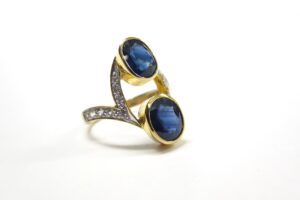Shopping for fine jewelry and semi-precious jewelry should be exciting and fun. But unfortunately for jewelry lovers and businesses investing in jewelry lines, there may come a point when you are offered pieces that aren’t the real deal. Luckily, with a little education, it is fairly easy to spot fake pieces and distinguish them from quality jewels.
Don’t waste your time and money on pieces that don’t meet your standards for quality and originality—read our top tips for spotting fake jewelry so you can protect yourself before you buy.
Telltale Signs of Fake Gold
Quality gold pieces are often stamped, indicating their purity. Check the clasp on your necklace or bracelet, or the inside of a ring, to see if you can find a stamp there. Sometimes forgeries will have their own stamps—so while this can be a strong first step in determining what a piece is made from, it isn’t necessarily reliable in every situation.
There’s another easy trick that will help you quickly distinguish real gold from lower quality metals: all you need is a magnet. Genuine gold is not magnetic and will not stick to a magnet at all, while jewelry that is made from a lower quality metal will leap to the magnet and stick instantly.
Finally, the density of gold is easily measured compared to cheaper metals. Gold is quite dense and therefore should sink when placed in a bowl of water. If your piece floats, then it is not dense enough to be genuine.
Distinguishing Real Silver
Like gold, sterling silver is stamped to indicate its purity: real sterling will say .925 somewhere on the piece, indicating that it is composed of 92.5 percent silver. Some people are under the (false) impression that real silver doesn’t tarnish, but that’s not true. A genuine silver piece will polish up to its original shine quickly, while a fake silver piece made from something like nickel or cobalt will not recover its original sheen no matter how much you polish it.
There are plenty of tests you can do to determine whether a piece is made from genuine silver (or gold, or platinum) or an imitation, and being able to do just one of these experiments for each type of metal will generally be worth your while.
Tips for Diamonds
Most often, imitation diamonds are made out of materials that mimic the shine and polish of these stones: glass, plastic, and other stones, including moissanite and cubic zirconia, are all passed off as diamonds to unsuspecting buyers. Luckily there are plenty of ways to tell whether a diamond is real that don’t necessarily involve taking your jewelry to a lab. Examine the setting of the piece and consider the overall quality: does the setting look professional and secure? Are there any marks on the piece, indicating what kind of metal was used? Chances are, no one would set a diamond in an inexpensive metal, so do consider the appearance of the stone and the setting together when trying to evaluate quality.
Diamonds do not hold heat, so one easy way to see if a diamond in a piece of jewelry is real is to breathe on it: an imitation stone or other material will fog up, but the fog will fade from the surface of a genuine diamond immediately. Diamonds are cherished because of their inimitable shine and sparkle, so another way to judge a diamond piece is to examine the kind of light that it gives off.

Precious Stones
Imitations of precious gemstones may be a fine choice for fashion jewelry, but you definitely don’t wait to pay the authentic-level price for a fake! One, perhaps paradoxical-seeming, way to tell the difference between precious stones and imitations is to look for subtle flaws in the stones. Genuine stones are the result of uncontrolled, natural formation processes and thus will have very faint flecks, differences in color, and other characteristics that indicate they have not been manmade. Fake gemstones, on the other hand, will appear perfect and will not have these imperfections.
Gemstones like rubies and sapphires are known to be very hard, so you can perform a scratch test on any pieces containing these stones. Scratch your fingernail across the surface of each stone: it if leaves a mark, you are dealing with an imitation. Another clue that a stone has been man-made include bubbles underneath the surface; this is especially common in imitation emeralds.
Semi-Precious Stones
Imitations of semi-precious stones, like jade, amethyst, turquoise, and other popular gems are also found in fake jewelry, and though these stones don’t cost as much as precious stones, you will want to be aware of how to spot the real deal.
One way to distinguish between real and fake gemstones it to look at the setting. The genuine gemstones can be set in a solid-back setting, while fakes gem may be mounted with foil behind them as a way to make the fake gem look brighter. Another giveaway is the feeling and density of the stone: real gemstones will feel heavy and slightly cool to the touch (compared to plastics or other man-made materials that do not). Different kinds of tests work for different stone types, so be sure to familiarize yourself with these tests before you make a purchase.
Differences in Construction and Detailing
Overall quality in the construction of a piece is often one of the easiest ways to spot fake jewelry without doing any tests. Are the findings and clasps in good order? Are there any scratches or places where the metal appears to be worn? Does the weight feel appropriate to the piece, or does it feel too light to made of real metals and stones? While there is a lot of science and study that goes into determining whether something is genuine or fake, many times your eye and your intuition will also help you discover whether a piece is authentic or not.
While fake jewelry is something all buyers need to watch out for, a little bit of education goes a long way. Get to know what kinds of materials you can expect for both fashion and fine jewelry, and understand the basic properties of the major fine and fashion jewelry metals and stones. Once you are empowered with some basic jewelry knowledge, you’ll be at much less risk of making a bad purchase.



